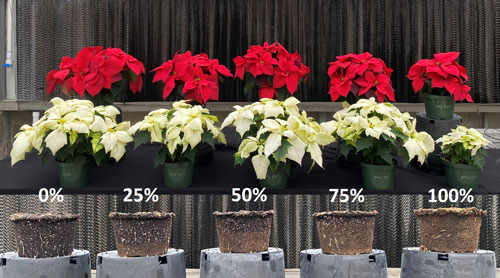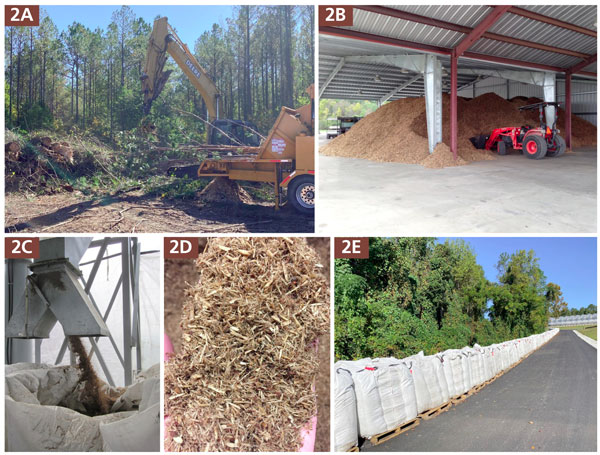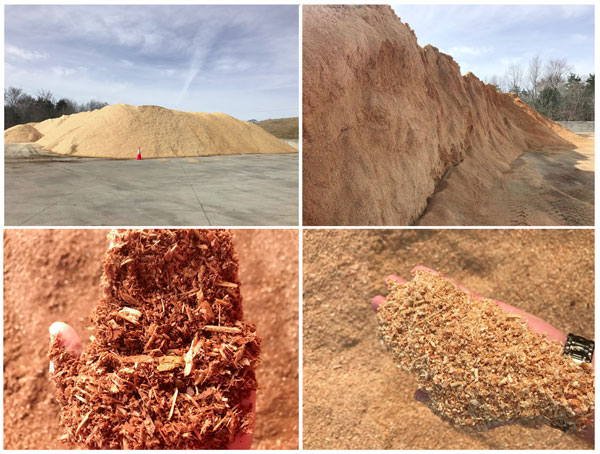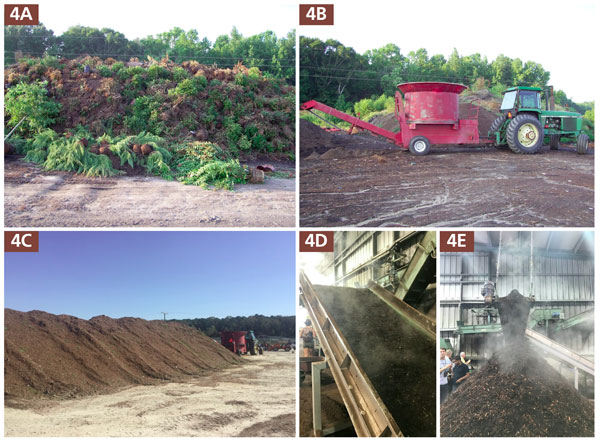1/1/2023
Navigating Through Substrate Shortages
Dr. Brian E. Jackson

Will the recent innovations and shift in substrate composition, use and management be a thing of the past or the beginning of the “new normal” for producing crops in soilless growing systems? Evidence suggests the latter option is more likely to be the case.
Figure 1. Layering cheaper components like wood under peat may be an effective way to extend peat supplies and cut costs for growers.
Some of the efforts by growers to find alternative substrate sources or to extend/stretch existing peat supplies are summarized below. (Note many other viable approaches and products not mentioned here also exist.)
Growing media in the media
While soilless growing media has always been an important topic, the challenges and market shifts of the past three years have exposed greater interest, concern and overall public awareness of these materials. Most of the heightened concern was in response to product shortages (particularly peat, perlite and vermiculite) due to demand and transportation gridlock. There’s also been a growing spotlight on the future availability, use and sustainability of peat, the most relied-upon substrate component.
Just recently, in Europe, for example, on November 18, 2022, a coalition of 14 European organizations entered into a “Peat Pact” by signing the Environmental Impact of Potting Soil and Substrates Covenant, which commits to the reduction of peat use, the accelerated use of renewable raw substrate materials, reuse of substrates and enablement of responsible peat extraction.
 Furthermore, in the past year alone, peat and growing media has been discussed, debated or highlighted in various trade publications (including here in GrowerTalks), mass media sources like The New York Times, The BBC, Popular Science, National Geographic, and at Congressional meetings on Capitol Hill in Washington, D.C., Parliament Hill in Ottawa, Canada, and at the EU Parliament in Brussels.
Furthermore, in the past year alone, peat and growing media has been discussed, debated or highlighted in various trade publications (including here in GrowerTalks), mass media sources like The New York Times, The BBC, Popular Science, National Geographic, and at Congressional meetings on Capitol Hill in Washington, D.C., Parliament Hill in Ottawa, Canada, and at the EU Parliament in Brussels.
Figure 2. Wood substrate production at grower operations continues to be an economical and successful approach to substrate supply security.
This coverage can be beneficial to increase public and industry awareness of the critically important role substrates play in the future of plant production and national/food security—assuming the narratives are accurate and based on science and facts, and not cherry-picked pieces of information that make a story more appealing to the general audience.
Grower responses to peat shortages
In response to the peat shortages in recent years due to increased demand, pandemic-related obstacles and wet summers preventing optimal peat extraction, growers reacted in different ways to find the substrate volumes they needed.
One approach adopted by some growers was to layer or “stratify” different substrates in containers. This practice uses cheaper and more readily available substrate materials under peat-based mixes. Mima Stoeva, Director of Growing Operations at Rockwell Farms in North Carolina has conducted large-scale trials on this technique and has been pleased with the results, saying that they haven’t seen any issues with placing 30% bark fines in the bottom of containers, thereby reducing their peat usage.
She reports that in addition to less peat being needed, they’ve reduced fertility in certain crops, have seen good root growth responses and that overall plant quality is equal to plants grown in non-layered regular mixes.
Stratifying substrates is a concept not only with benefits of reducing peat usage, but also improved water and nutrient use efficiency as shown by Drs. Jeb Field (Louisiana State University) and Jim Owen (USDA-ARS). University-industry partnerships are currently working to further test this application, including poinsettia trials conducted this fall at North Carolina State University (NCSU) in the Horticultural Substrates lab.
 Pine tree substrate (hammer-milled pine wood) was layered under peat in 25%, 50% and 75% increments (Figure 1). A control mix of peat:perlite was tested, as was a 100% wood substrate, and all plants were fertigated the same. Results varied by cultivar, but all were successful (comparable to control) with even the 75% wood layer rate producing plants of very high quality. There’s tremendous potential in this approach/practice in the future.
Pine tree substrate (hammer-milled pine wood) was layered under peat in 25%, 50% and 75% increments (Figure 1). A control mix of peat:perlite was tested, as was a 100% wood substrate, and all plants were fertigated the same. Results varied by cultivar, but all were successful (comparable to control) with even the 75% wood layer rate producing plants of very high quality. There’s tremendous potential in this approach/practice in the future.
Figure 3. Many growers are acquiring wood shavings, sawdust and other forest residuals from sawmills to use in substrate formulation.
Growers like Young’s Plant Farm in Alabama have been successfully producing their own hammer-milled wood substrate for over a decade (Figure 2). This practice not only reduces their dependency on peat moss, but it offers something equally as valuable—internal security of substrate supply. Having the unique capability to harvest trees from their own property (Figure 2A), hammer mill and store it on site (Figures 2B to E) enables them to make as much as they need based on the availability (or cost) of other components. Other growers like American Color in Virginia have also invested in this practice.
Looking into the future, it’s likely that more growers or grower consortiums could decide to produce their own wood substrate materials in this way. I think it’s only a matter of time before substrate companies also consider this strategy of wood and bark procurement for use in producing substrates. While most all wood substrates today are made from loblolly pine (Pinus taeda), current efforts at NCSU with industry partners around the country are aggressively exploring west coast and northern coniferous species to expand the options and regionality of this renewable resource.
Many other growers are opting to source and use sawdust and other forest residuals from sawmills (Figure 3). These products are very different than the commercialized engineered wood fiber products on the market. While being significantly cheaper than the commercial wood materials, they also come with higher risks and production management challenges. The sawdust piles have to be managed, care taken to make sure the fresh/green wood toxins are removed before using and that the variation in particle size doesn’t create uniformity issues in the physical properties of the final mix.
Metrolina Greenhouse in North Carolina has been using some of these sawmill products since 2017 and has been successful in reducing perlite usage, as well as some portion of peat. Looking ahead to 2023 in response to raw peat moss being difficult or impossible to get, they’re planning to make/use a mix consisting of one-third peat, one-third sawdust and one-third commercial wood fiber. Mark Yelanich, Director of Research at Metrolina says they’re cautious about this approach, but that it’s necessary in light of not getting the peat moss volumes they need now and likely in the future. He stated that they would be adapting their fertility and irrigation practices, and closely monitoring crop growth and make changes as needed.
Lastly, a common question or interest by many growers has been the feasibility to reuse or recycle substrates (Figure 4). For some production operations, this could be culled plants that weren’t sold or not of saleable quality that often form mini-mountains outside of greenhouses and nurseries. These plants are ground up and piled or windrowed before possibly being sterilized for future reuse (Figures 4D to E).
 For other operations—like mushroom production, cut flowers, leafy greens, cannabis, other vertical/CEA crops, etc.—that don’t sell the substrate with the plant it would be the entire substrate (plus root system) with the potential of being repurposed. There are risks associated with recycling substrates in this manner, even when sterilized. The potential of high salts (EC), degraded physical properties and carryover pathogens or chemical residues are possible concerns. Some growers and researchers are exploring the use of these recycled substrates as possible materials to use in the bottom of pots in the layering technique discussed earlier.
For other operations—like mushroom production, cut flowers, leafy greens, cannabis, other vertical/CEA crops, etc.—that don’t sell the substrate with the plant it would be the entire substrate (plus root system) with the potential of being repurposed. There are risks associated with recycling substrates in this manner, even when sterilized. The potential of high salts (EC), degraded physical properties and carryover pathogens or chemical residues are possible concerns. Some growers and researchers are exploring the use of these recycled substrates as possible materials to use in the bottom of pots in the layering technique discussed earlier.
Figure 4. Using recycled/spent substrates or substrates from culled plants has increased in recent years to supplement or stretch peat/coir supplies.
Wood products are, of course, not the only viable option that growers have when sourcing alternative substrates. Numerous other commercial products are on the market for use in loose-fill mixes, including biochar materials, Pittmoss, recycled rockwool, palm core fiber, composts, etc. For propagation and CEA producers, there are also a variety of stabilized media products, Pure Life Carbon and foam technologies (PeatFoam, MooreFoam, GrowFoam, etc.) available. These and other peat-free products are available, some fairly localized and regional, but others with national distribution.
Looking ahead
The current outlook for substrate supplies and availability in 2023 still has some uncertainties. Peat extraction in Canada during the summer of 2022 was unable to meet target volume goals due to wet weather preventing maximum harvests. Peat suppliers have still mostly limited or stopped the sale of raw peat (something likely to not change in the future) to growers and only offer pre-blended mixes instead.
Coconut coir supply appears to be sufficient across the U.S. due to sea freight charges being back to nearly pre-pandemic rates and due to previously back-ordered shipments that have now been delivered.
Perlite supplies and availability have bounced back and don’t seem to be limited in the year ahead. Vermiculite availability remains low from most all suppliers and will likely remain difficult to purchase in the near future. Rockwool supplies also seem to be stable and readily available.
Wood products should also be readily available in the year ahead because of increased production capacity of existing wood fiber suppliers and the much-anticipated arrival of new wood substrate providers and products on the market. It’s still highly recommended and very much the “new norm” for growers to order products early, even a year or more in advance, if possible.
“Never waste a good crisis” is likely a philosophy difficult for many to understand or agree with. However, if the innovations, production efficiencies and cost-saving practices created or implemented over the past three years are shown to be long-term effective strategies, then maybe at some point in the future we look back to see 2020 to 2022 as a turning point in how the horticulture industry can quickly evolve to be successful in our ever-changing world and the unknown challenges in it that surely await. GT
Brian E. Jackson is a Professor and Director of the Horticultural Substrates Laboratory at North Carolina State University. He can be reached at Brian_Jackson@ncsu.edu.